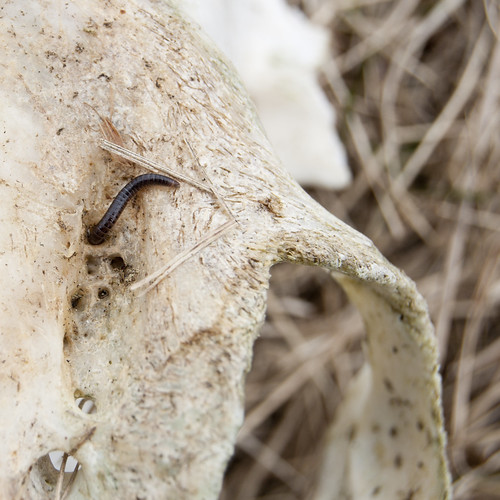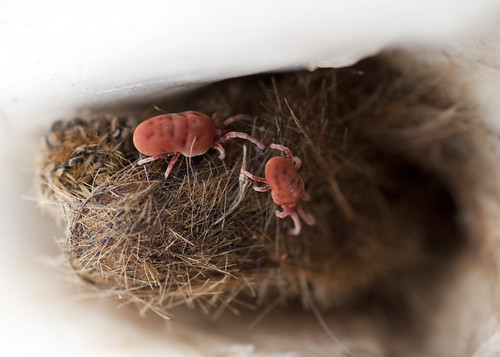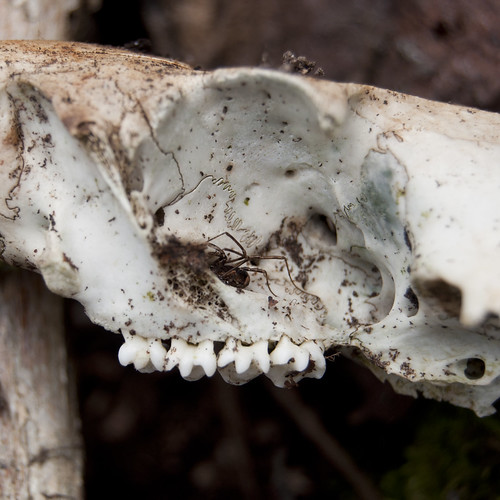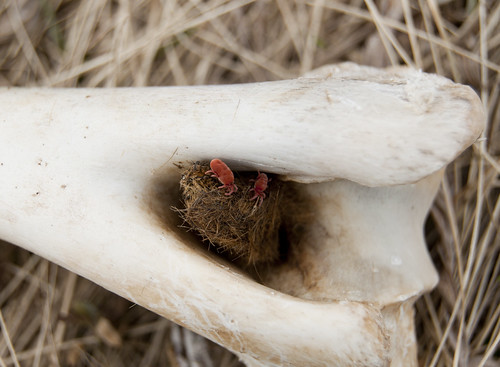I encountered the remains of several deer, including this doe skull. It was resting in the middle of a field, with no other bones nearby; the long exposure to the sun had bleached the skull a bright white, unmistakable in a sea of brown grass. I turned the skull over -- and what did I see?

A tiny millipede -- the first of several I saw that day, all using bones as their shelter. I made sure to turn the doe skull back to its original position; I have no doubt there were many other creatures living inside.
Nearby, I found the bones of another deer, this time a buck whose antlers had long-since been removed. While most of the skeleton was relatively intact and more or less articulated, the skull and a few of the leg bones had been scattered further away. I turned one of the leg bones to see what I could find; not only was there a strange cocoon wedged into a hollow of the bone, but also two velvet mites milling around on the surface of the cocoon.

Nearby, I found the bones of another deer, this time a buck whose antlers had long-since been removed. While most of the skeleton was relatively intact and more or less articulated, the skull and a few of the leg bones had been scattered further away. I turned one of the leg bones to see what I could find; not only was there a strange cocoon wedged into a hollow of the bone, but also two velvet mites milling around on the surface of the cocoon.

Velvet mites are something I don't see very often, but when I do, I'm always happy to watch their behavior. They're quite large (for mites), so it's pretty easy to observe them. I'm not sure what the mites were up to, but judging by their different sizes, I'm guessing it was a male and female, the female being the larger of the two. They interacted for a while, touching legs and scurrying about.
The last find of the afternoon had far better camouflage than the bright-red velvet mites:

The last find of the afternoon had far better camouflage than the bright-red velvet mites:

This daddy long-legs (order Opiliones, also known as harvestmen) was squeezed into a furrow of this woodchuck skull, looking a lot like the nearby dirt and other organic matter.
It has become obvious to me that bones, especially skulls, are very important to insects, arachnids, and other terrestrial arthropods. Not only are dead animals a source of food, but they provide shelter, as well. During the cold, snowy, and icy months of a Michigan winter, skeletons become instrumental in keeping our invertebrates safe and dry.
See also -- Bone Home, June 23 2010.
It has become obvious to me that bones, especially skulls, are very important to insects, arachnids, and other terrestrial arthropods. Not only are dead animals a source of food, but they provide shelter, as well. During the cold, snowy, and icy months of a Michigan winter, skeletons become instrumental in keeping our invertebrates safe and dry.
See also -- Bone Home, June 23 2010.





Your blog is fantastic. The velvet mites are beautifully photographed.
ReplyDeleteThank you! The mites were especially fun to photograph and watch so closely.
ReplyDelete